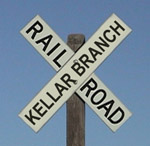 The Surface Transportation Board has finally issued their ruling: The city cannot kick Pioneer Railcorp (PIRY) off the Kellar Branch. Pioneer may start serving Carver Lumber via the Kellar immediately. The STB explains their reasoning this way:
The Surface Transportation Board has finally issued their ruling: The city cannot kick Pioneer Railcorp (PIRY) off the Kellar Branch. Pioneer may start serving Carver Lumber via the Kellar immediately. The STB explains their reasoning this way:
Often, a line owner seeking an adverse discontinuance wishes to dispossess a tenant because the tenant has breached an obligation to the line owner, has failed to provide adequate service to the public, or both. None of those types of circumstances has been demonstrated to exist here. The issue of whether PIRY’s contract with the Cities has expired remains pending in state court, which is the proper forum to adjudicate that claim. The only existing shipper that would be affected by the proposed discontinuance, Carver Lumber, has repeatedly complained about CIRY’s [Central Illinois Railroad Company’s] service and wants PIRY’s rail service on the Kellar Branch to be restored. PIRY states that it is willing and able to provide that service, and the record suggests that there may be new potential shippers.
…
Based on the record now before us, we find that the Cities have failed to meet their burden of establishing that the PC&N [public convenience and necessity] requires or permits the adverse discontinuance of PIRY’s operations. The City has not shown that the benefits of removing our primary jurisdiction would outweigh the harm to Carver Lumber, PIRY, and interstate commerce in general. [emphasis mine] The adverse discontinuance application will therefore be denied.
This ruling essentially says that the Kellar Branch is more important for interstate commerce than as a hiking trail. I’m sure the Journal Star editorial writers will be pulling an all-nighter to write a scathing rebuke of the STB for tomorrow’s paper.
I’ll have more to say later, but wanted to get this breaking news up on my blog as soon as possible.
UPDATE 1: Here’s reaction to the ruling from City Manager Randy Oliver:
The Surface Transportation Board has denied the City of Peoria’s motion for adverse discontinuance of Pioneer Rail. The immediate effect is that there are now two railroads authorized to operate on the City’ rail line. This will require a joint operating agreement between the two railroads with authority from the STB. It is unclear which railroad will initiate the negotiations, however, that is best determined by the two railroads involved.
UPDATE 2: At-large city councilman Gary Sandberg had this reaction to today’s ruling:
I think it is wonderful and consistent with what I have been saying for 7 years. Pioneer has proven itself as the best rail service provider. Hopefully Carver and additional users can now begin serious planning for reliable, affordable rail service along the Kellar. Additionally, I trust [Pioneer] will work in a positive fashion to share the ROW for trail purposes where it will not interfere with a working rail line.
UPDATE 3: Peoria Park Board President Tim Cassidy had this to say in response to my request for the Park District’s reaction to the ruling:
Thanks for a copy of the decision. I was not aware a decision had been issued. At this point there is on official PPD reaction, because we as a board have not met to discuss it. Personally, I am not that familiar with federal rail law to comment. It does seem the law on the books is somewhat archaic, but the administrative agency is obligated to apply the law. I do not know if it did given there is a dissent, which to me got it right.
I hadn’t noticed before, but there was a Surface Transportation Board member who dissented from this decision. Here’s what he had to say:
VICE CHAIRMAN BUTTREY, dissenting:
The majority is undoing the Board’s August 2005 decision granting adverse discontinuance of PIRY’s service over the Kellar Branch because Carver Lumber is unhappy with CIRY’s rates and service over the Western Connection. But CIRY states on the record that it stands ready, willing and able to provide adequate service to Carver Lumber (CIRY Supplemental Evidence and Comments filed February 22, 2007, at pages 7-9). Carver Lumber has a reasonable transportation alternative and is clearly not captive under Board precedent, since it has been transloading and trucking its inbound lumber shipments. And Carver Lumber has not brought its rate and service complaints to the Board under our processes for addressing rate and service issues.
The City spent approximately $2 million to provide the Western Connection to allow Carver Lumber to be served from the west (Verified Statement of City Public Works Director Stephen Van Winkle at page 5, part of the City’s Statement filed February 22, 2007). The City of Peoria has been subsidizing continuation of rail service over the Kellar Branch for many years (id. at pages 1-2). The Board knew when it authorized construction of the Western Connection in 2004 that this expensive project was part of a larger plan by the City to reconfigure and provide service to Carver Lumber through this new route in order to free up the underutilized Kellar Branch and turn it into a pedestrian trail through downtown Peoria. I see no reason on this record to disturb the Board’s earlier determination.
I respectfully dissent.
It should be noted that even if the STB had made the “right” decision according to Mr. Cassidy (i.e., removed Pioneer as a carrier on the Kellar Branch), it wouldn’t have discontinued service on the line; it would have simply made CIRY the sole operator of the line, and there’s no evidence that they plan to petition for discontinuance on any part of the Kellar Branch.
UPDATE 4: I talked to Peoria Heights Mayor Mark Allen tonight. His village, often forgotten in the rail/trail issue, is perhaps the most affected, since the bulk of the proposed conversion to a trail would take place within the village limits. He said he was “disappointed” with the ruling, but didn’t feel that it would “scare off” proposed development of the former Cohen’s Furniture warehouse area. He wishes the STB would have made their ruling provisional on new rail shippers coming on line within the next one, two, or five years. If new users and accompanying jobs didn’t materialize, then the rail could be converted to a trail. He still feels the trail would be “the best economic engine to the village,” because there’s currently no freight delivery in the Heights, and he doesn’t believe there’s much chance of manufacturing returning within village limits. Freight rail cars simply passing through the village don’t contribute to the village’s economy.
I asked him what he thought of the possibility of running the trail next to the rail line. He felt that would be problematic for a couple of reasons. He doesn’t think the right-of-way is wide enough south of Prospect, for one. Secondly, the right-of-way north of Prospect, while wide enough, would not provide enough buffer between the trail and residents’ back yards if the trail had to be on the edge, rather than the middle, of the right-of-way. He didn’t rule out the possibility of shared use, but said these two things are obstacles that would have to be overcome for that solution to happen.
He would still be interested in a transit solution — running a trolley on the rail line — but only if other governmental bodies were to jump on board with the idea. So far, all governmental bodies (except the STB) have favored a trail rather than anything rail-oriented.
UPDATE 5 (11/20): I asked Sharon Deckard, president of the Illinois Prairie Railroad Foundation and the proponent of trolley service along the Kellar Branch line, what she thought of the ruling and if IPRRF still planned to pursue trolley service. She had this to say:
At this point in time we are pleased to see that STB has finally made a ruling and that Pioneer Railcorp has offered an olive branch to the trail proponents. With all parties working together we can have the best for everyone in the community.
As far as the trolley is concerned we would hope that some time in the future, possibly when Amtrak arrives in Peoria, we will then realize the need for commuter light rail (trolley) to run on the Kellar Branch.
In the meantime we wish the rail and trail proponents the very best in their endeavors.


 The Surface Transportation Board has finally
The Surface Transportation Board has finally